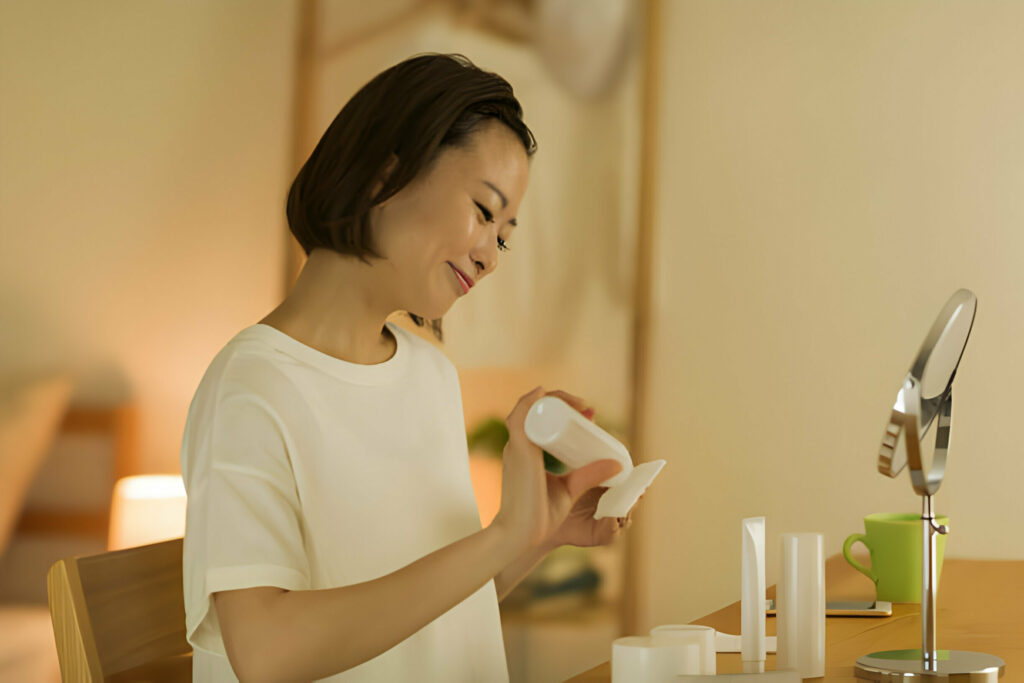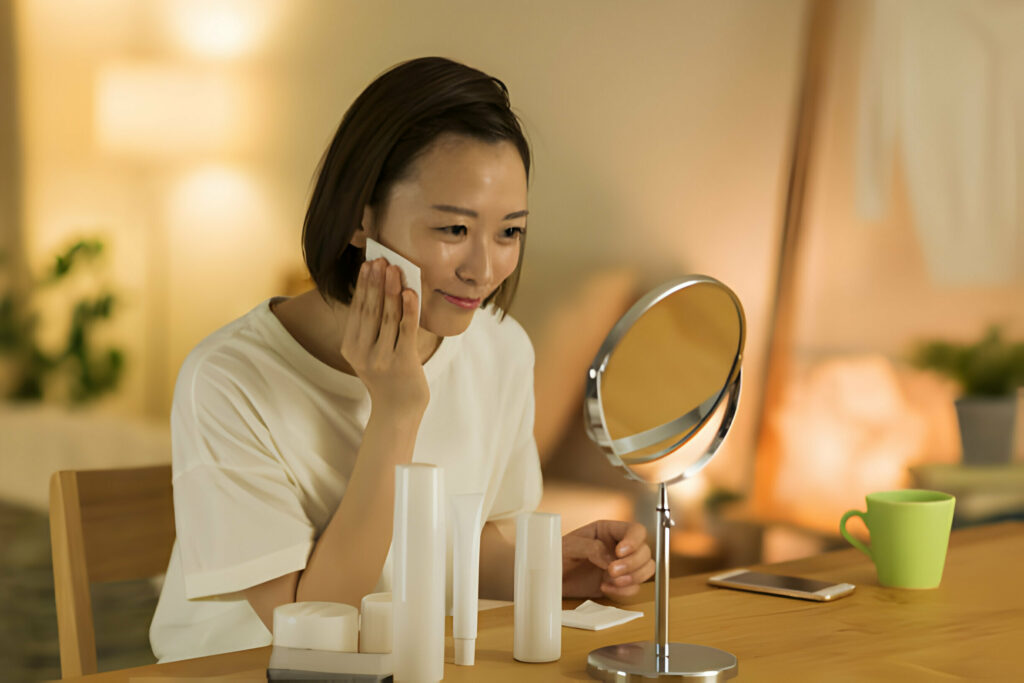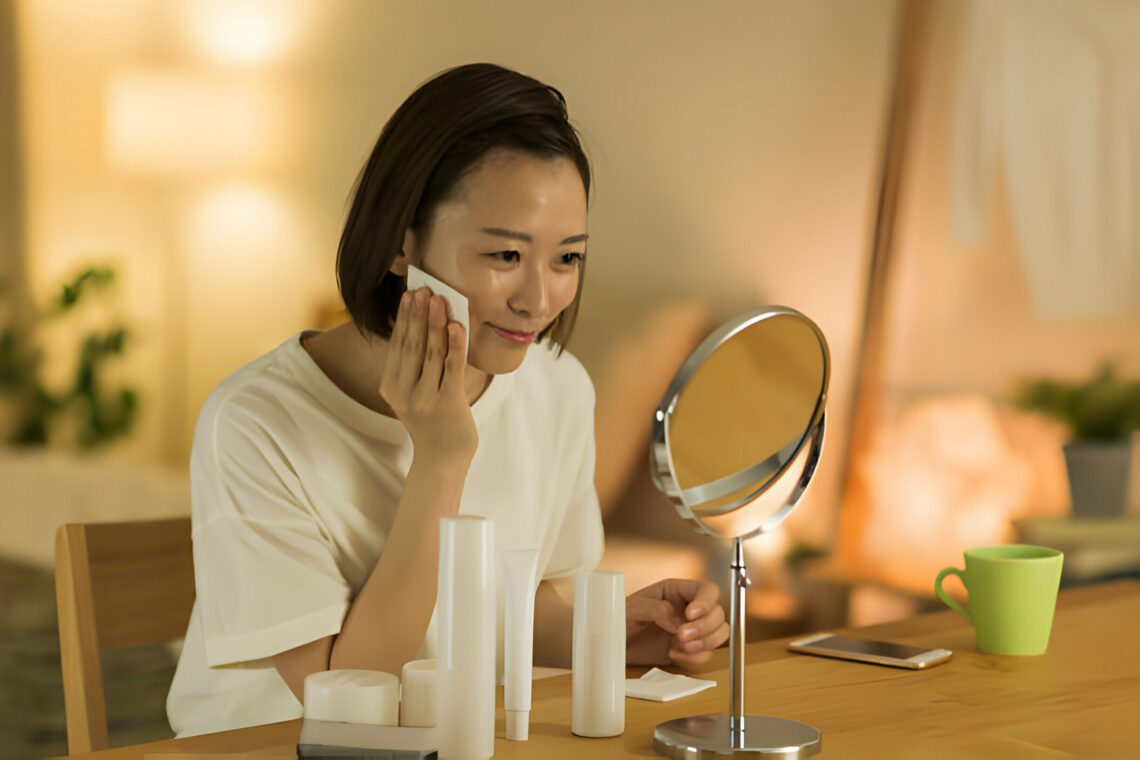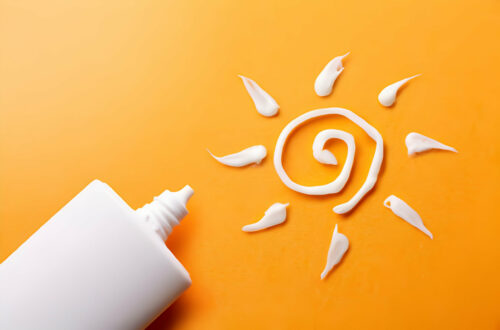Let’s face it—skincare can feel daunting. With each person’s skin being unique, copying someone else’s routine is no guarantee of success. And when you factor in the distinction between morning and evening products, the complexity only grows.
But fear not, there’s a universally endorsed step-by-step approach that’s akin to an essay outline. In this guide, we’ll delve into the fundamentals of establishing a nighttime skincare regimen, unravel the significance of each step, and provide select product recommendations to simplify your quest:
Step 1: Eliminate Makeup and SPF. Commence by removing your makeup and SPF using an oil cleanser or micellar water, a technique commonly referred to as double-cleansing in the morning skin care routine. Ditch the makeup wipes as they can be harsh on the skin and are not environmentally friendly
According to organic esthetician Katie Sobelman, “Oil cleansing is beneficial for all skin types, as it delicately lifts away impurities, grime, and makeup without causing harm to the skin.” Gently massage the oil cleanser onto dry skin, and then introduce a little water to transform the formulation into an emulsion before rinsing it away.
For those prone to breakouts, Sobelman advises steering clear of coconut oil. She explains, “Coconut oil’s molecular size is relatively large, making it more likely to clog pores.” Instead, opt for products containing squalene or jojoba oil.

Step 2: Purify Your Skin. Post-oil cleansing, transition to a dedicated facial wash – an essential step in your routine. Katie Sobelman elucidates, “The oil cleanser clears surface buildup, allowing a water-based cleanser to effectively purify the skin.”
For individuals with dry skin, choose a hydrating cleanser. Those prone to acne might find solace in cleansers infused with AHAs or BHAs (such as lactic acid or salicylic acid). Sensitivity calls for a gentle, fragrance-free option.
If seeking a physical exfoliant, steer clear of harsh scrubs containing shells, fruit pits, or plastic microbeads – these can cause micro-tears in the skin. Skip abrasive facial cleansing brushes too, as dermatologists recommend a manual approach. If needed, consider a soft silicone pad, that exerts minimal pressure.
Step 3: Revitalize with Toner or Essence. Toner—controversial for some, indispensable for others, including summer skin care routine aficionados. “I genuinely regard toning as the cornerstone of your skincare regimen,” affirms Katie Sobelman. Beyond elevating hydration, toner assists in pH equilibrium, particularly after Step 2, where the choice of cleanser can cause disturbances.
“An imbalanced pH impedes optimal product absorption,” cautions Sobelman. While milder cleansers may mitigate this concern, a meticulously crafted toner contributes moisture and primes the skin for subsequent treatments and serums.
A vast array of toners exists, catering to distinct needs. Some prioritize hydration, others regulate oil production, while many nourish the skin’s microbiome with pre- and postbiotics.

Step 4: Elevate with Targeted Treatment. This phase isn’t a nightly constant. Simplifying this concept, let’s delve into “skin cycling,” a term pioneered by board-certified dermatologist Dr. Whitney Bowe, M.D., FAAD. Essentially, it entails a structured regimen of cycling through treatment stages to sidestep irritation and excessive exfoliation.
The cycle spans four days. On the initial night, incorporate an exfoliating serum—think AHAs and BHAs. Following this, embrace a retinoid the next night, be it over-the-counter retinol or prescription-grade formulas. Preceding retinoid use, exfoliating aids in shedding dead skin, paving the way for the retinoid’s efficacy. Subsequently, for the two nights post-retinol, abstain from treatment, a “recovery night,” as Dr. Bowe terms it.
In choosing chemical exfoliants and retinoids, a gradual potency ascent is recommended. For sensitive skin types, employing a moisturizer both before and post-retinoid application (known as the “sandwich method”) can deter irritation.
“Refrain from simultaneous use of multiple active ingredients to avert potential irritation,” advises board-certified dermatologist Dr. Joshua Zechner, M.D., FAAD. This rule prevails, regardless of your product cycling approach. Adhering to a skin cycling strategy should facilitate this. Just remember to exclude toners with AHAs or BHAs on your retinol night.
Step 5: Nourish Your Eye Area. Did you realize that the skin beneath your eyes differs from the skin on your cheeks and forehead? Katie Sobelman elaborates, “The under-eye skin is notably thinner compared to the rest of the face, rendering it susceptible to stress, resulting in sagging, fine lines, discoloration, and puffiness.” This elucidates the significance of the eye cream step.
When choosing an eye cream, pinpoint a specific objective to identify the optimal product: Aiming to alleviate fine lines. Contemplate a retinol-infused eye cream. Seeking to illuminate dark circles? Opt for a vitamin C-enriched solution. Craving hydration or firmness? Embrace hyaluronic acid and peptides. Aspiring to de-puff? Caffeine stands as a stellar choice.
Step 6: Hydrate and Restore. Moisturizing is an essential follow-up to every cleanse, both in the morning and at night, including winter skin care routine. “Even the gentlest cleansing disrupts the skin’s natural barrier and its innate oils that lock in moisture. Moisturizers play a crucial role in repairing this disruption,” elucidates board-certified dermatologist Dr. Elyse Love, M.D., FAAD.
Irrespective of your particular skin type, embracing a richer moisturizer in the evening and a lighter variant in the morning yields benefits. “Skin hydration levels typically diminish from afternoon to evening, making richer night creams valuable,” details Dr. Zeichner.

Your ingredient preferences will largely align with your skin type, including a skin care routine for 30s. Those with oil-prone skin can derive benefits from oil-free, gel-textured moisturizers, which hydrate without contributing to excess oiliness. Surprisingly, certain moisturizers designed for oily skin incorporate elements like niacinamide, aiding in sebum regulation. Delve into a guide spotlighting optimal moisturizers for oily skin and selection strategies.
For individuals with dry skin, opt for a denser cream to reinvigorate moisture. Ceramides, peptides, and omega-3 fatty acids serve as effective tools against dryness.
On exfoliant-free nights (recovery nights), a supplemental step might intrigue you: applying an occlusive layer post-moisturization, a practice referred to as “slugging.” Dr. Love notes, “Slugging can assist a compromised skin barrier, post-procedures, flare-ups of eczema or rosacea, overuse of exfoliants, or during harsh weather conditions.” Explore a compilation of top-notch clean and natural face oils if you’re ready to embrace slugging.
Decoding Your Skin Type: A Practical Guide.
Certainly, don’t overlook the task of identifying your skin type. This crucial step will act as a compass for your product selection, allowing you to curate each phase according to your skin’s distinct requirements. Deciphering your skin type need not be an intricate process, even if it initially feels daunting—ultimately, it’s about keen observation and attentive listening.
Initiate by pondering the following inquiries: As the day progresses, does your skin tend towards dryness, oiliness, or equilibrium? What specific skin concerns trouble you, such as wrinkles, acne, dry patches, and the like? Does your skin exhibit reactions to topical products, manifesting as redness, itching, or burning? For those commencing their journey, Dr. Zeichner suggests this straightforward test:
“After cleansing your face, wait for half an hour and study your reflection in the bathroom mirror. If your skin appears shiny, you likely have oily skin. If you notice flakiness or dullness, you’re probably on the drier side,” he advises. If you observe oiliness in the T-zone coupled with dryness on the cheeks, you might possess combination skin.

The fundamental skin types encompass dry, oily, combination, acne-prone, and sensitive. Bear in mind, you needn’t exclusively fit into one category or another—dry and acne-prone skin can coexist.
An excessive fixation on skin type can occasionally lead down an unproductive path. For instance, if your skin tends to be oily yet becomes drier during winter, opting for a moisturizer traditionally formulated for combination skin is an intelligent choice. “Focusing solely on skin type can sometimes be overwhelming. Instead, consider what your skin is yearning for,” suggests Dr. Love.
The Key Points to Remember. Establishing a new skin care regimen might appear perplexing, but this blueprint serves as a foundation to initiate your evening routine, including skin care routine for 40s and skin care routine for 50s, irrespective of your skin type. Keep in mind the importance of alternating exfoliation with recovery nights a couple of times each week, and avoid combining chemical exfoliants with retinoids. Above all, heed your skin’s cues and provide it with the care it craves. As a steadfast rule, if you’re grappling with skin conditions like acne or eczema, seeking guidance from a dermatologist is the optimal route to navigate this journey together.





